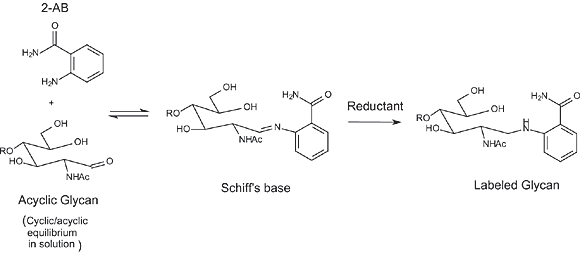Glycoprofile™ Labeling Kits
The GlycoProfile™ Labeling Kits are designed for efficient labeling of N-linked, O-linked and glycosylphosphatidylinositol (GPI) anchored glycans using your choice of 2-aminobenzamide (2-AB) or 2-aminobenzoic acid (anthranilic acid; 2-AA) 1,2. These small fluorophores increase the spectral absorption of glycans, improving detection in HPAE (high-performance anion exchange chromatography),3-6 HPLC4-7, and ESI-MS (electrospray mass spectroscopy) methods. Binding is robust and the resulting dye-glycan conjugates are stable, with no degradation during post-labeling analysis. 2-AB is recommended for downstream analysis by HPAE, HPLC and ESI-MS, although it is slightly less sensitive than 2-AA. 2-AA is recommended for SDS-PAGE, and is also suitable for HPAE, HPLC and ESI-MS.

Figure 1.Labeling of carbohydrates with 2-AB
Features and Benefits
- Each kit is complete, containing 2-AA or 2-AB dye, reductant and solvents.
- Sufficient for the preparation of up to 36 samples of mixed glycans containing from 100 picomoles to 50 nanomoles of purified glycans. With a single pure glycan, as little as 5 picomoles may be labeled and detected in subsequent HPLC analysis.
Note: Labeling of glycans with 2-AB is covered under US Patent No 5,747,347 and its foreign equivalents.
GlycoProfile™ Glycan Clean-Up Cartridges are recommended for use with the GlycoProfile Labeling kits for post-labeling cleanup. Glycans adsorb to the membrane while excess dye, mono- and disaccharides and other hydrophobic contaminants pass through. Purified labeled glycans are eluted with water and are ready for subsequent enzymatic digestion or analysis.
Materials
References
To continue reading please sign in or create an account.
Don't Have An Account?